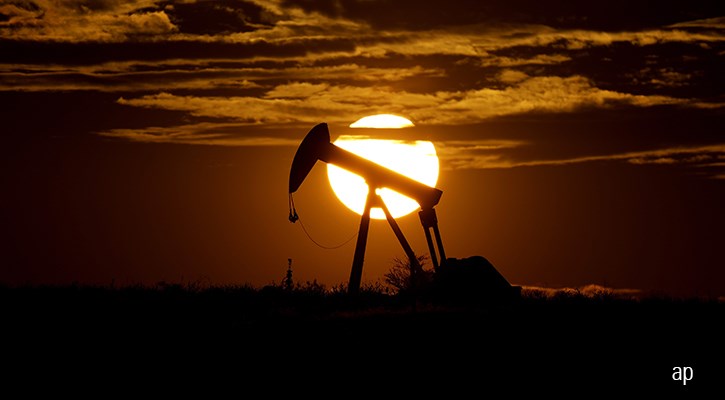
Last week, the Canadian energy sector was dealt another blow when the world’s largest sovereign wealth fund decided to divest from four Canadian oil companies, citing ‘unacceptable greenhouse gas emissions’.
Norges Bank said in a statement that the bank’s executive board has, “decided to exclude the companies Canadian Natural Resources (CNQ), Cenovus Energy (CVE), Suncor Energy (SU),and Imperial Oil (IMO) after an assessment that acts or omissions that on an aggregate company level lead to unacceptable greenhouse gas emissions. The Council on Ethics recommended to exclude the companies because of carbon emissions from production of oil to oil sands. It is the first time this criterion is being applied.”
This is just the latest in a series of blows to Canadian oil. Last month, for the first time in history global crude slipped into negative territory, as demand collapsed due to the COVID-19 pandemic, while supply stayed steady, leading to an unprecedented storage shortfall. Buyers were paying up to US$37 per barrel of oil to offload their trades.
Candice Bangsund Vice President and Portfolio Manager Fiera Capital called it “a perfect storm for prices.” Though these were global figures, she pointed out that we saw the same sort of trends in the Canadian space. “Crude prices in Canada are also on the decline, because of a general lack of demand, and again, no storage. There's no buyers out there and what's accentuated the volatility in that downside is the fact that the sellers are far outpacing the buyers right now,” she said.
Canadian oil has even more problems. Morningstar analyst Joe Gemino believes that we will see oil supply decrease in Canada due to curtailment, ramp down of crude by rail contracts, and less drilling activity. “Because of that, discounts aren’t expected to widen and might even narrow some over the next two years. However, prices will be extremely low and almost all production will be uneconomical,” he says.
And in the middle of this bleak landscape, Norges Bank came in with its decision to divest from the beleaguered sector.
Canadian oil and ESG
It’s hard to talk about Canadian investing in general without discussing oil. Energy makes up almost 14% of the S&P/TSX Composite Index, and oil is a major employer and contributor to the economy.
But at the same time, with climate change a key concern for many, how will all this tie in with ESG investing, especially when, as Jackie Cook, director of sustainability stewardship research for Morningstar, points out, investors will be under increased pressure to reduce their exposure to fossil fuels? “Companies and projects operating under weak regulatory oversight will be at greater risk as investors consider the heightened reputational risks of fossil fuel investments,” Cook says.
Despite this, some investors see opportunities. ESG-focused fund company NEI Investments includes energy as a focus area, and actively invests in the sector. In this year’s Corporate Engagement Focus List, of the 26 names, four are in Canadian Energy, three of which are Suncor, Canadian Natural Resources and Cenovus.
“Our take around the energy companies in Canada is that we think they are a key part of our energy transition and that they have a role to play. There's opportunities to diversify, whether it's getting into biofuels, whether it's looking at renewables in a serious way, things like hydrogen, things like building a lithium industry out of the existing infrastructure that we have, ideas that oil sands companies are working on around bitumen beyond the barrel, what can you do with bitumen that doesn't involve burning things like carbon fibre? These are all opportunities that can be explored,” explains Jamie Bonham, Director of Corporate Engagement at NEI Investments, when asked if energy and ESG can coexist.
“Unconventional oil sources with the highest emissions levels are believed to have little to no growth trajectory in a low-carbon future. It could still be possible for Canadian energy companies to expand production if technological innovation improves the emission intensity of oil sands to comparable levels of lighter oils. However, we caution that the drive to reduce carbon emissions in oil sands extraction could increase production costs, which could erode any gains from the improved efficiency,” says Sustainalytics research Manager Jose Yakoubian.
Bonham points out that nothing fundamental has changed in NEI’s understanding of the risks facing the energy industry in Canada as a result of Norges Bank’s divestment. “It has been very clear – for some time now – that climate-related risks are a material concern, if not THE material concern. If anything, this just underscores the importance of the work done in working with investors, companies, regulators, and governments on aligning the industry – and the Canadian economy – with the energy transition. That work will continue to be a priority.”
To Bonham and NEI it absolutely does make sense to continue engagement with oil companies. “If your goal is impact then engagement is extremely relevant. There is no doubt that investors are starting to gravitate towards the solutions and opportunities that align with a low-carbon future. If Canadian oil & gas companies want to remain viable in that future they have to make the case to investors that they fit into that future. To be clear, we think they can, but it isn’t a given and it will take some bold vision and innovation. It will also take a certain boldness from investors to not only support this innovation but to push for more. It is very important for the Canadian economy for this sector to continue to prosper but it has to look radically different than what it looked like yesterday. That won’t happen overnight, and it likely won’t happen without investors supporting that vision, but it can happen,” he says.
Alberta’s government isn’t helping
To see whether it can indeed happen, investors and advocates are closely watching the response of the Alberta government, where a majority of the oilsands are located. What has happened so far is not particularly encouraging for ESG investors.
“The Alberta government has become the oil patch’s own worst enemy by weakening environmental monitoring and oversight to the extent that foreign investors and foreign companies alike face reputational risks by investing in oilsands companies and projects. Following on from budget cuts and layoffs at the Alberta Energy Regulator late last year, in early April the UCP government suspended reporting requirements under provincial environmental legislation for three months during the COVID-19 pandemic. Then earlier this month, it announced further limiting oilsands oversight as a COVID-19 measure by suspending monitoring at 16 oilsands projects,” says Cook.
Of the four companies that requested this relief measure, three are on Norges’ exclusion list – Suncor, Imperial Oil, and Canadian Natural Resources, and these same three are also on the Climate Action 100+ list of globally systemically significant emitters targeted for engagements.
What next for the excluded companies?
The fact is that with all this attention, investor pressure is going to require Canadian firms to take leadership.
“This is not a new story for the sector, just a new name involved. But it may help tilt the playing field for those internal champions who have been advocating for bolder transition strategies,” says Bonham, adding that nothing will change with NEI’s engagement with the three companies on the focus list. “We have been engaging companies in the sector on the imperative of the energy transition for over a decade and we have seen some really substantive change during that time. I think most everyone (companies included) would agree that the pace of change in recent years is both unprecedented, but also not nearly enough. Conversations on achieving a net-zero future and aligning with the Paris Agreement will continue to be a focus,” he says.
So in the face of this, the main question then is, will other funds and global investors follow Norges Bank’s lead?
Others to follow Norges Bank’s strategy?
“The move is likely to raise similar concerns among other investors, particularly asset owners, and is also likely to make foreign companies more concerned about investing in oilsands projects,” points out Cook. She notes that globally, large asset owners are driving a more forceful ESG stewardship agenda and are expecting the same from their asset managers.
“While divestment precludes stewardship, this move by the largest sovereign wealth fund strengthens the arm of other investors in their engagements with oil and gas companies in general and with those on Norges’ exclusion list in particular. My reading of this is that Norges’ exclusions also draw attention to the risks resulting from the oil sector’s political capture in Alberta,” Cook says.
Bonham says it would be surprising if other funds did not follow Norges Bank’s lead, but engagement is also gaining traction.
Progress
At the end of last month, ESG advocates got a rare win in Canadian energy, when 56% of the shareholders of Ovintiv (OVV) vote in favour of climate change disclosure proposal, and asked the oil and gas producer for specific climate-related targets aligned with the Paris Agreement.
The resolution filed by the Pension Plan of the United Church of Canada, supported by the Shareholder Association for Research & Education (SHARE) sought disclosure from Ovintiv regarding climate-related targets that address medium and long-term climate related risks and opportunities, and that align the company's objectives with the goals of the Paris Agreement.
This was the first Paris-aligned targets proposal to get majority support at a Canadian company. “It’s especially significant to get that result when the proposal was opposed by management,” pointed out Anthony Schein, director of shareholder advocacy at SHARE.
Success in the low carbon economy
Learn about the companies best positioned to survive and thrive



















